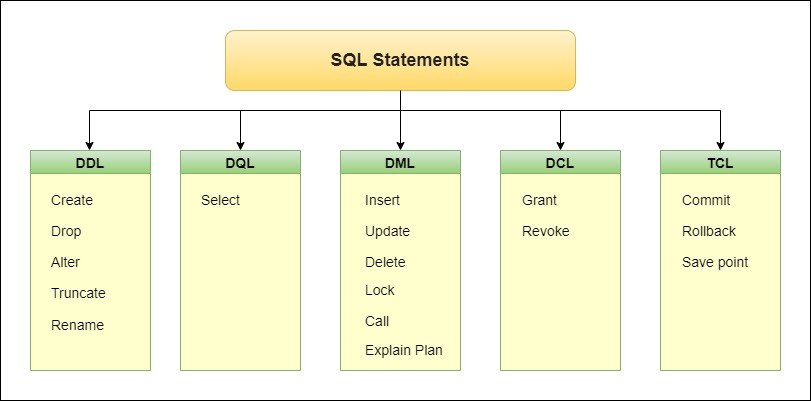sql
overview

- DQL: date query
- DDL: data definition;
- action:
- create
- drop
- alter
- truncate;
- object:
- table
- index
- database;
- event;
- view
- trigger
- action:
- DML: update/delete/insert
- DCL: data control
- grant
- revoke
sql
- write order
|
|
- run order
- FROM/JOIN clause: determine the total data set;
- WHERE clause:
- GROUP BY clause
- HAVING clause
- SELECT clause
- DISTINCT
- ORDER BY clause
1. subquery/ nested query
|
|
correlated subquery
vs normal subquery:
-
normal subquery would excuted once
-
correlated subquery will
- correlate with outer table
- excuted each row
|
|
having vs where
both of them are used for filter datas;
|
|
- where filter before select
- having:filter after select;
|
|
function
string function
- append string: select concat(“name:",name)…
aggregate functions
perform a caculation on mutiple rows, result in one value;
- count
- sum()
- max/min
- avg
group
group by column = map[column]
|
|
group by column1, column2; map[colum + column]
mutiple table
join vs union vs subquery
- vs
- join: 左右连接 select t1.name, t2.age from t1 join t2 on t1.id=t2.id
- union: 上下连接: select name,age from t1 union select name,age from t2;
- subquery:嵌套在其他selct 语句中
join
1. purpose
join columns in other table;
vs union: join row in other table;
2. join type
|
|
select left.id,right.id from left join right on left.id=right.id
-
left/right: list left/all right item;
- left: [1,2,3,4],[1,2,3,null]
- right: [1,2,3,5], [1,2,3,null]
-
inner: list rows only left and right match;
- [1,2,3],[1,2,3]
-
outer: get all row on left and right table;
- [1,2,3,4,null],[1,2,3,null,5]
-
left/right: 通过外键去join left: a.[id, foreignKey]->b.[id], a.foreginkey=b.id right a.[id,….] <- b.[id,foregin] b.foreginkey=a.id
union
join different rows in
sql in practice
1. select max(min) value per row
+——–+————+——-+ | type | variety | price | +——–+————+——-+ | apple | gala | 2.79 | | apple | fuji | 0.24 | | apple | limbertwig | 2.87 | | orange | valencia | 3.59 | | orange | navel | 9.36 | | pear | bradford | 6.05 | | pear | bartlett | 2.14 | | cherry | bing | 2.55 | | cherry | chelan | 6.33 | +——–+————+——-+
|
|
privilege
mysql_secure_installation
secure the initial accunt (root)
- set a password for root account;
- remove anonymous account;
|
|
create a new user
- create user
|
|
- assign privilege
GRANT privilege on db.table to ‘user@address’
|
|
privilege type:
- ALL PRIVILEGES
- CREATE
- DROP
- DELETE
- INSERT
- SELECT
- UPDATE
- GRANT
DDL
1. constraint
-
rule of the data column;
-
list:
- value:
- not null
- default 0
- key:
-
unique ke
UNIQUE KEY [name] (field,field2...) -
primary key
-
foreign key
FOREIGN KEY (field) REFERENCES tablename(field) -
index key
KEY [name] (field1, field2,)
-
- check
1constraint c1_nozero check (age <> 0)
- value:
create table
|
|
preload
what:
- 加载与我们要查询的表以及有关联表的所有数据
- 不适用join,而是使用多次查询
|
|